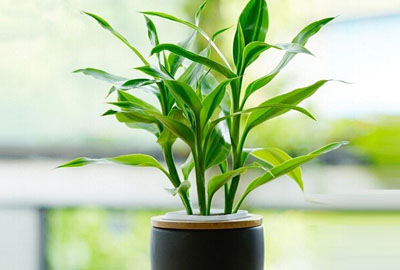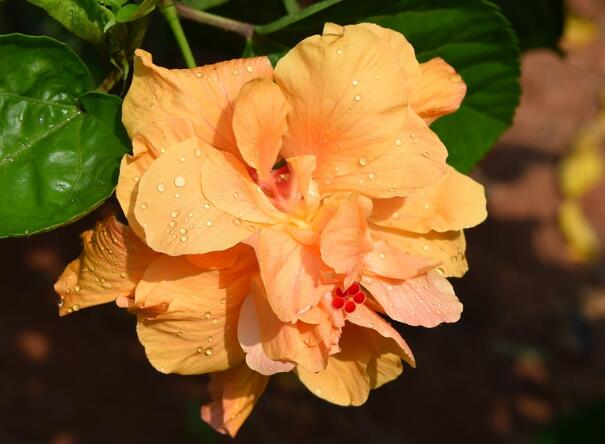What if the leaves of rich bamboo turn yellow in water? How to solve it?
Rich bamboo is a plant that is very easy to grow indoors, as long as it is put in water and can be fed by changing water regularly. at the same time, it can tolerate low light environment, but it is easy to have yellow leaves or rotten roots, so it is necessary to master certain planting techniques when breeding. what about the yellowing leaves of water-fed rich bamboo? How to solve it?

Causes of yellowing of leaves of Phyllostachys pubescens cultured in water
1. Check the water quality mainly to see whether the roots are fresh. If the roots rot due to water quality, you should switch to cold boiled water.
2. Check the lighting conditions of the place, such as dark light, stuffy air, dry air, etc., which will cause the leaves to turn yellow; but if the light is too strong, it will also cause the leaves to turn yellow and lose their mind.
The solution of yellowing of leaves of Phyllostachys pubescens raised by water
1. Lighting
If it is caused by light, the yellow leaves can be cut off first, and the rotten roots should also be cut off, so as to create a clean, warm, cool, moist and better environment with scattered light. If it is the root rot caused by unclean water quality, the yellow leaves can be cut off first. when the symptoms are not serious, the water should be changed frequently and placed in a ventilated and sunny position for restorative maintenance; when the symptoms are serious, pesticides should be sprayed properly or a small amount of fungicide should be added to the water plate.
Temperature
It is evergreen woody, sexual like high temperature, high humidity environment, but also shade, waterlogging resistance, has a certain cold resistance, when the winter temperature is lower than 10 ℃, the leaves will yellowing and falling off.
As an indoor ornamental, it generally does not add nutrients to the soaking solution of rich bamboo to prevent stem node decay, it is better to use overnight tap water or cold boiled water, it can be replaced every 10 to 15 days, and every 5 to 7 days in summer, but only half of it needs to be poured out each time, and the new half should not be completely replaced, otherwise the root system will not be able to adapt. If you want to make the water-raised rich bamboo continue to grow, you can add a small amount of urea and potassium dihydrogen phosphate aqueous solution to the soaking solution, the concentration can be controlled at about 0.1%, change every half a month, and the fertilizer solution can also be sprayed on the leaf surface. When it grows more new buds, it should cut off the diseased buds and infected buds as soon as possible, otherwise it will bring damage to the whole basin of rich and noble bamboo; for thin and weak buds, "overlord buds" and so on, on the premise of not affecting the overall shape and ornamental appearance of rich and valuable bamboos, it is also necessary to give adaptive thinning. Add an atmosphere of tranquility, warmth and happiness.
Humidity
Phyllostachys pubescens originated in the Canary Islands and tropical regions of Africa and Asia, and is now widely introduced and cultivated in China. Its sex likes the high temperature and high humidity environment, the request to the light is not strict, like the light also can bear the shade. It is suitable for growing in sandy loam with good drainage. The suitable temperature for growth is 20 ℃ and 30 ℃, and the overwintering temperature is 10 min.
Reproduction method
Rich bamboo is propagated by cuttings. Cuttings are mostly combined with shaping and pruning. With the growth and height of the plant for many years, the leaves at the base of the stem often fall off, and the shape of the plant becomes worse; in the growing season, the stem can be cut at 5 cm and 10 cm as cuttings, which can be cut in vermiculite or river sand, which can take root and sprout in 2 weeks.
Soil
The pot cultivation of rich bamboo can be planted with the same amount of rotten leaf soil, garden soil and river sand, or coconut bran and rotten leaf soil plus a small amount of base fertilizer as culture soil. The key to management is to master humidity and temperature. The growing season should often keep the basin soil moist, and often spray water to the leaf surface, in order to maintain a higher environmental humidity, too dry will make the leaf tip dry; in winter, the basin soil should not be too damp, but it is often necessary to spray water to the leaf surface, and pay attention to cold prevention work at the same time, so as to prevent the leaves from yellowing, atrophy and even shedding. Liquid fertilizer or granular compound fertilizer was applied 3 times a month from May to September to keep the leaves green and bright. It is not strict with light and is suitable to grow under bright scattered light to avoid direct sunlight. If exposed or dried, it will make the leaves rough, scorched, lack of luster and reduce the ornamental value.
Time: 2019-04-12 Click:
- Prev

How can sweet-scented osmanthus be raised well? What problems do you need to pay attention to?
At the mention of sweet-scented osmanthus, it reminds people of sweet-scented osmanthus in full bloom, the air is filled with sweet-scented osmanthus, smelling very intoxicating, then how to raise sweet-scented osmanthus? What do you need to pay attention to? Soil sweet-scented osmanthus is not strict to the soil, and it can grow under normal conditions.
- Next

How to raise Fusang? Detailed explanation of breeding methods and precautions of Fusang
Hibiscus flower alias hibiscus, big safflower, hibiscus peony, goblin flower, flower language for fresh love, subtle beauty. Hibiscus flowers are beautiful and beautiful. Many people like to cultivate hibiscus flowers on balconies or courtyards. What is the cultivation method of hibiscus flowers? What are the areas that need attention in the breeding process?
Related
- Fuxing push coffee new agricultural production and marketing class: lack of small-scale processing plants
- Jujube rice field leisure farm deep ploughing Yilan for five years to create a space for organic food and play
- Nongyu Farm-A trial of organic papaya for brave women with advanced technology
- Four points for attention in the prevention and control of diseases and insect pests of edible fungi
- How to add nutrient solution to Edible Fungi
- Is there any good way to control edible fungus mites?
- Open Inoculation Technology of Edible Fungi
- Is there any clever way to use fertilizer for edible fungus in winter?
- What agents are used to kill the pathogens of edible fungi in the mushroom shed?
- Rapid drying of Edible Fungi

